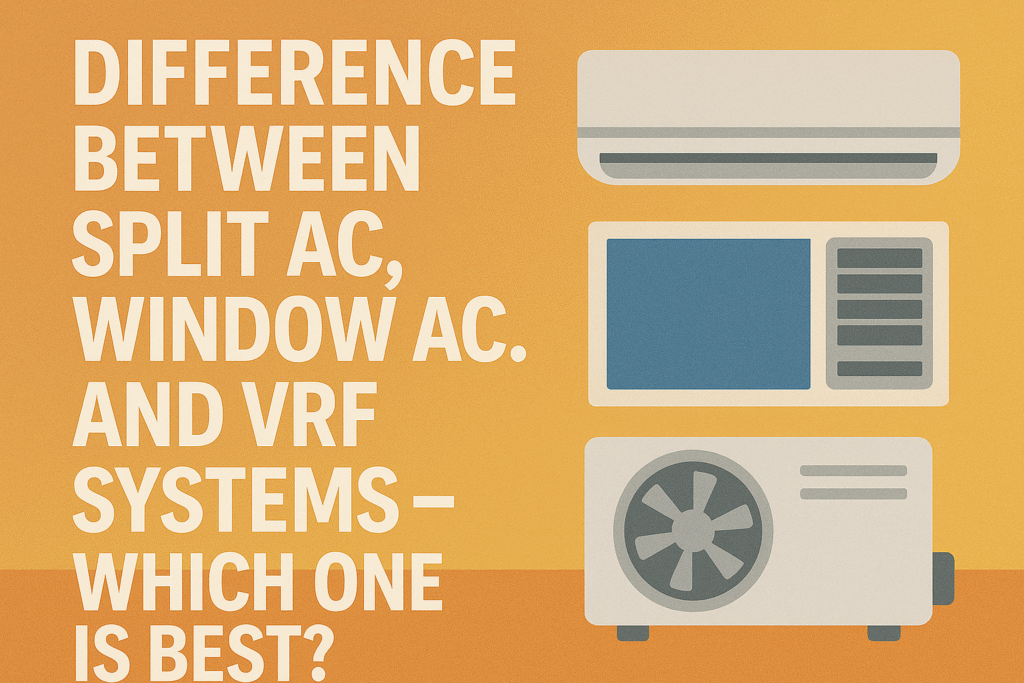When choosing an air conditioning system for your home or office, understanding the differences between Split AC, Window AC, and VRF (Variable Refrigerant Flow) systems is crucial. Each has unique features, advantages, and ideal use cases.
In this detailed guide, we’ll compare these three popular cooling systems to help you make an informed decision.
Window Air Conditioner (Window AC)
What is a Window AC?
A Window AC is a single-unit system installed in a window or a specially made wall opening. It houses all components (compressor, condenser, evaporator, and blower) in one compact unit.
Pros of Window AC
✔ Affordable – Lower upfront cost compared to Split and VRF systems.
✔ Easy Installation – No ductwork or complex setup required.
✔ Space-Saving – Ideal for small rooms where floor space is limited.
Cons of Window AC
✖ Noisy Operation – The compressor is inside the room, leading to louder performance.
✖ Limited Cooling Capacity – Best suited for small to medium-sized rooms.
✖ Blocks Window Space – Requires a window or wall cutout for installation.
Best For:
- Small apartments
- Single rooms
- Budget-conscious buyers
Split Air Conditioner (Split AC)
What is a Split AC?
A Split AC consists of two main units:
- Indoor Unit (Evaporator & Blower) – Mounted inside the room.
- Outdoor Unit (Compressor & Condenser) – Placed outside the building.
Pros of Split AC
✔ Quieter Operation – Noisy components are outside.
✔ Better Aesthetics – Sleek indoor design blends with interiors.
✔ Higher Energy Efficiency – Inverter models save electricity.
✔ Flexible Installation – Can cool multiple rooms with multi-split systems.
Cons of Split AC
✖ Higher Cost – More expensive than Window ACs.
✖ Complex Installation – Requires professional setup.
Best For:
- Homes & offices
- Medium to large rooms
- People looking for a balance between cost & performance
Variable Refrigerant Flow (VRF) System
What is a VRF System?
A VRF system (also called VRV – Variable Refrigerant Volume) is an advanced HVAC solution that allows precise temperature control in multiple zones using a single outdoor unit connected to several indoor units.
Pros of VRF System
✔ Highly Energy Efficient – Adjusts refrigerant flow based on demand.
✔ Simultaneous Heating & Cooling – Some models provide both in different zones.
✔ Scalable for Large Spaces – Ideal for commercial buildings, hotels, and large homes.
✔ Quiet & Consistent Performance – Minimal noise and superior comfort.
Cons of VRF System
✖ Very High Initial Cost – Most expensive among the three.
✖ Complex Installation & Maintenance – Requires expert technicians.
Best For:
- Large commercial spaces
- Luxury homes
- Buildings needing zonal climate control
Comparison Table: Split AC vs. Window AC vs. VRF System
| Feature | Window AC | Split AC | VRF System |
| Cost | Low | Medium | High |
| Installation | Simple | Moderate | Complex |
| Noise Level | High | Low | Very Low |
| Energy Efficiency | Low-Medium | Medium-High | Very High |
| Cooling Capacity | Small-Medium | Medium-Large | Large-Commercial |
| Best For | Small Rooms | Homes/Offices | Large Buildings |
Which One Should You Choose?
- For Budget Cooling in Small Rooms → Window AC
- For Balanced Performance in Homes → Split AC
- For Large Spaces & Maximum Efficiency → VRF System
Final Thoughts
Each air conditioning system has its strengths. Your choice depends on budget, room size, and cooling needs. If you need personalized advice, consult an HVAC expert for the best solution. For those considering a career in HVAC systems, check out our detailed post on How to Become an HVAC Engineer.”

